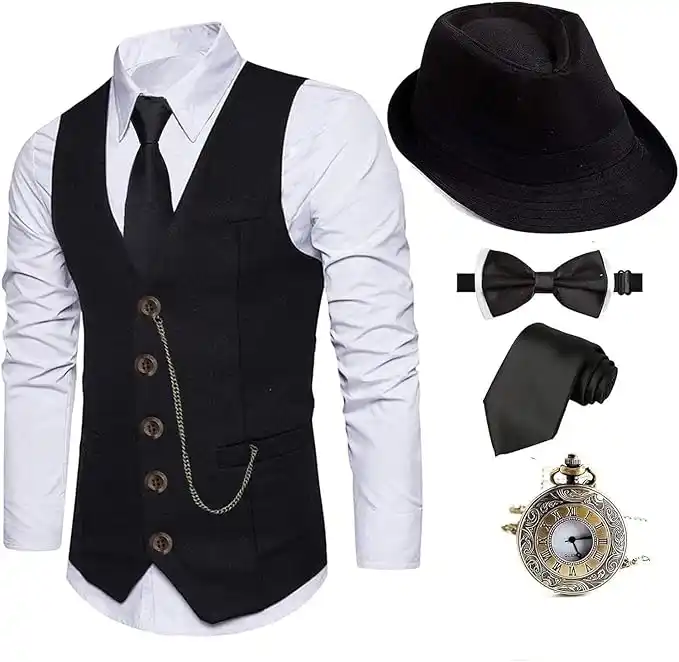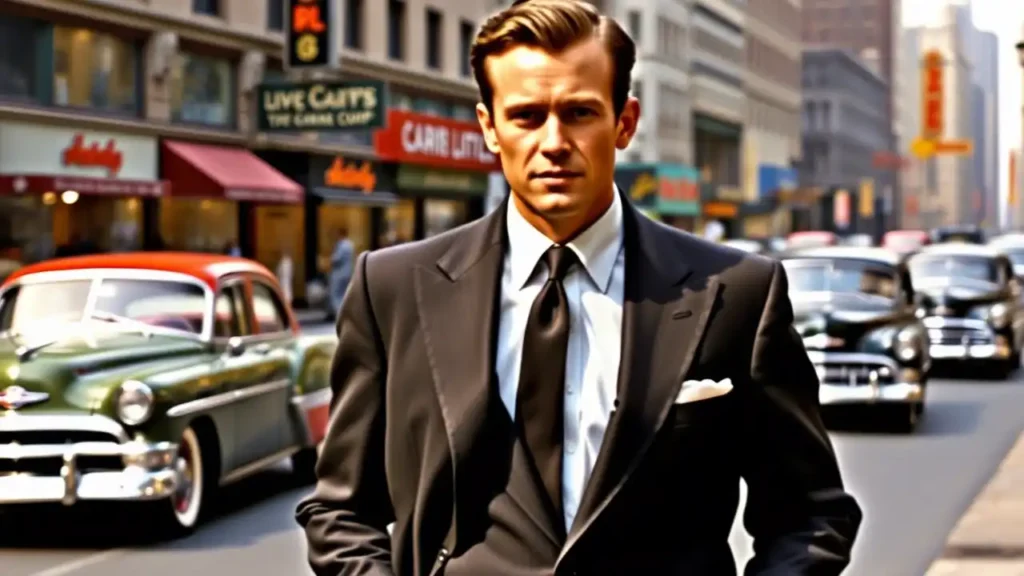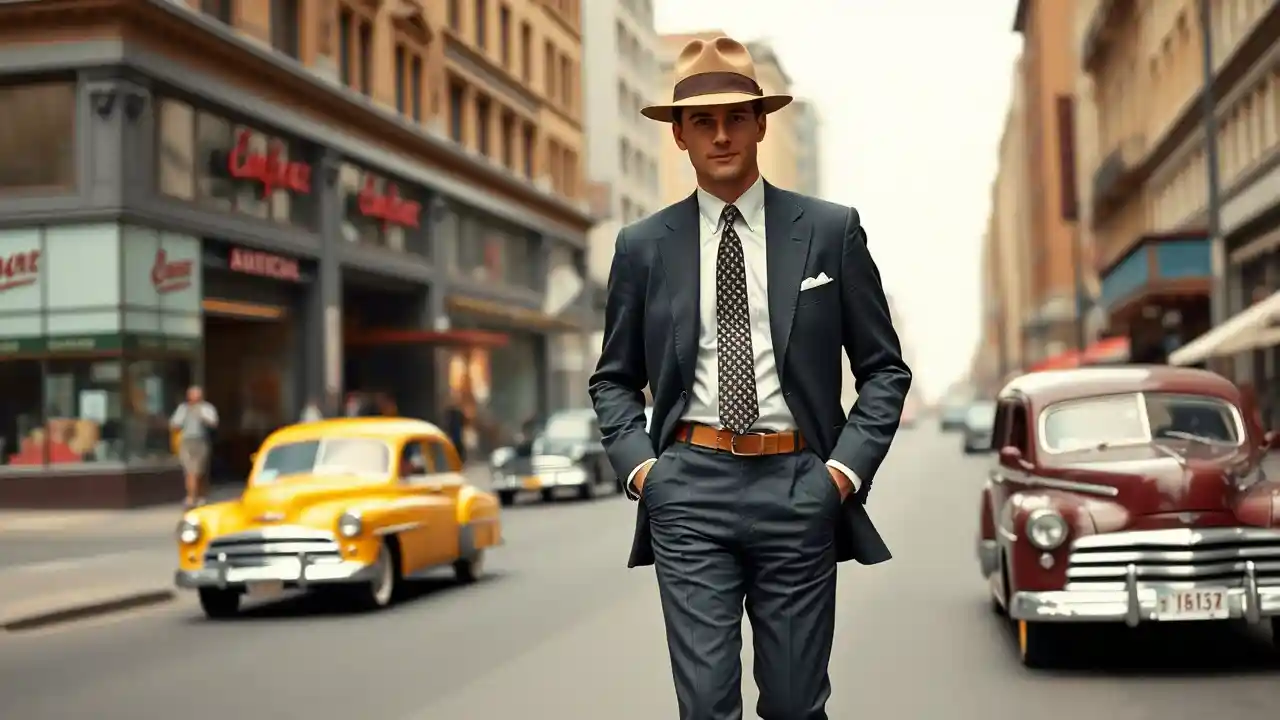The 1950s mens fashion marked a watershed moment in men’s fashion—an era where traditional boundaries dissolved and new forms of masculine expression emerged from the chrysalis of post-war prosperity.
This transformative decade gave birth to fashion innovations that would become timeless standards, from the perfectly tailored suit to the iconic leather jacket. What began as a period of unprecedented economic growth evolved into a cultural revolution, with clothing at its very center.
Today’s resurgence of 1950s aesthetics isn’t mere nostalgia—it’s a recognition of the decade’s enduring influence on how men dress and present themselves. This comprehensive exploration delves into the styles, influences, and cultural significance that made 1950s mens fashion a pivotal moment in sartorial history.
Contents
The Essence of 1950s Mens Fashion
Historical Context: The Perfect Storm
Manufacturing innovations born from wartime necessity now served civilian desires, producing higher-quality garments at more accessible price points.
This prosperity coincided with significant social changes. The rise of suburban living created new dress codes for work and leisure.

Men no longer simply wore suits for every occasion—they needed versatile wardrobes that could transition from office to backyard barbecue. This practical need for adaptability drove innovation in casual wear while maintaining high standards for formal attire.
Cultural Catalysts and Social Change
The explosion of youth culture in the 1950s fractured traditional fashion norms. Young men, backed by newly-acquired purchasing power, began rejecting their fathers’ rigid dress codes.
This generational divide manifested in two distinct directions: the rebellious greaser subculture and the sophisticated Ivy League look. Both styles, though radically different, represented youth-driven departures from conventional menswear.
Television’s growing influence played a crucial role in democratizing fashion. When viewers saw stars like Steve McQueen wearing casual clothing with the same confidence as formal wear, it legitimized more relaxed approaches to male dress.
The medium’s intimate nature allowed men to study and emulate style details they might have missed in movies or magazines.
Fashion Icons: The New Male Archetypes
The 1950s produced a pantheon of male style icons whose influence transcended their era:
James Dean embodied youthful rebellion through a carefully curated casual wardrobe. His combination of white t-shirts, denim, and leather jackets created a template for effortless cool that designers still reference today.
Marlon Brando brought raw masculinity to mainstream fashion. His portrayal of Stanley Kowalski in “A Streetcar Named Desire” elevated the plain white t-shirt from underwear to iconic garment, while “The Wild One” cemented the connection between motorcycles, leather jackets, and rebellion.
Frank Sinatra represented sophisticated adult style. His precisely tailored suits, often featuring narrow lapels and trim silhouettes, showed how traditional menswear could be both elegant and modern. Sinatra’s attention to details—from pocket squares to cuff links—influenced how men approached accessorizing.
Key Styles of the 1950s Mens Fashion
The Greaser Look: American Rebellion
The greaser aesthetic emerged from working-class youth culture, combining practical workwear with theatrical flourishes. This style’s enduring appeal lies in its accessibility and attitude:
Core Elements:
- Leather Jackets: Preferably Perfecto-style with asymmetrical zippers
- Denim: Levi’s 501s, worn high on the waist and cuffed
- T-Shirts: Plain white, fitted but not tight
- Boots: Engineer or harness styles, often by Frye or Red Wing
- Accessories: Leather wallet chains, bandanas, silver rings
The greaser look’s influence extended beyond clothing to grooming, with elaborate pompadours and ducktail hairstyles requiring significant daily maintenance. This attention to personal presentation challenged stereotypes about rebellious youth being unkempt or careless about their appearance.

The Ivy League Style: Educated Rebellion
While greasers rejected mainstream fashion, college students developed a sophisticated alternative to traditional business wear. The Ivy League look emphasized quality, understatement, and a studied casualness that influenced menswear globally:
Signature Elements:
- Sports Coats: Natural shoulders, 3/2 roll lapels, hook vents
- Oxford Cloth Button-Downs: Specifically the Brooks Brothers polo collar
- Khaki Chinos: Flat front, worn slightly shorter than standard trousers
- Penny Loafers: Bass Weejuns became the de facto campus shoe
- Accessories: Striped ties, collegiate scarves, leather briefcases
Essential 1950s Mens Fashion
Suits and Formal Wear: The Evolution of Elegance
The 1950s suit represented a dramatic departure from the broad-shouldered silhouettes of the 1940s. New tailoring techniques created a more natural shoulder line and trimmer fit:
Defining Characteristics:
- Jackets: Moderate shoulder padding, slightly nipped waist
- Trousers: High-waisted, pleated, with a slight taper
- Materials: Lightweight worsteds for summer, flannel for winter
- Colors: Charcoal grey dominated, followed by navy and brown
- Details: Narrow lapels, two-button closure, structured chest
Conclusion: The Enduring Influence of 1950s Mens Fashion
The 1950s represented more than just a golden age of American fashion—it was a laboratory for modern masculine identity. The decade’s greatest achievement was democratizing style while maintaining high standards of quality and presentation.
Whether through the rebellious spirit of the greaser look or the refined sophistication of Ivy League style, 1950s mens fashion created templates for personal expression that remain relevant today.
Contemporary designers consistently return to this era not just for aesthetic inspiration but for lessons in how clothing can balance pragmatism with personality. The decade’s emphasis on quality construction and versatile design continues to influence how we think about menswear.
As we navigate today’s fashion landscape, the principles established in the 1950s—attention to fit, appreciation for quality, and the importance of personal style—remain as relevant as ever.
The era’s greatest lesson may be that true style transcends trends, creating a dialogue between past and present that enriches both.
Whether you’re building a vintage-inspired wardrobe or simply appreciating the era’s influence on contemporary fashion, the 1950s Mens Fashion offer an inexhaustible source of style inspiration.
Visit your local vintage retailers to discover authentic pieces from this transformative decade.


